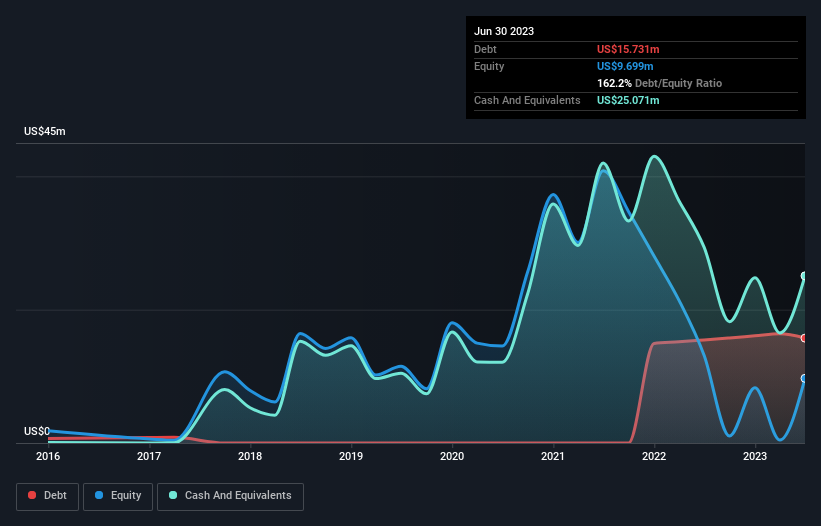- United States
- /
- Biotech
- /
- NasdaqCM:ACHV
Is Achieve Life Sciences (NASDAQ:ACHV) Using Debt In A Risky Way?

The external fund manager backed by Berkshire Hathaway's Charlie Munger, Li Lu, makes no bones about it when he says 'The biggest investment risk is not the volatility of prices, but whether you will suffer a permanent loss of capital.' When we think about how risky a company is, we always like to look at its use of debt, since debt overload can lead to ruin. Importantly, Achieve Life Sciences, Inc. (NASDAQ:ACHV) does carry debt. But should shareholders be worried about its use of debt?
When Is Debt A Problem?
Debt is a tool to help businesses grow, but if a business is incapable of paying off its lenders, then it exists at their mercy. Ultimately, if the company can't fulfill its legal obligations to repay debt, shareholders could walk away with nothing. However, a more usual (but still expensive) situation is where a company must dilute shareholders at a cheap share price simply to get debt under control. Having said that, the most common situation is where a company manages its debt reasonably well - and to its own advantage. When we examine debt levels, we first consider both cash and debt levels, together.
View our latest analysis for Achieve Life Sciences
What Is Achieve Life Sciences's Net Debt?
The chart below, which you can click on for greater detail, shows that Achieve Life Sciences had US$15.7m in debt in June 2023; about the same as the year before. But it also has US$25.1m in cash to offset that, meaning it has US$9.34m net cash.

How Healthy Is Achieve Life Sciences' Balance Sheet?
Zooming in on the latest balance sheet data, we can see that Achieve Life Sciences had liabilities of US$3.45m due within 12 months and liabilities of US$15.8m due beyond that. On the other hand, it had cash of US$25.1m and US$350.0k worth of receivables due within a year. So it actually has US$6.21m more liquid assets than total liabilities.
This short term liquidity is a sign that Achieve Life Sciences could probably pay off its debt with ease, as its balance sheet is far from stretched. Simply put, the fact that Achieve Life Sciences has more cash than debt is arguably a good indication that it can manage its debt safely. The balance sheet is clearly the area to focus on when you are analysing debt. But ultimately the future profitability of the business will decide if Achieve Life Sciences can strengthen its balance sheet over time. So if you're focused on the future you can check out this free report showing analyst profit forecasts.
Given its lack of meaningful operating revenue, Achieve Life Sciences shareholders no doubt hope it can fund itself until it has a profitable product.
So How Risky Is Achieve Life Sciences?
Statistically speaking companies that lose money are riskier than those that make money. And we do note that Achieve Life Sciences had an earnings before interest and tax (EBIT) loss, over the last year. And over the same period it saw negative free cash outflow of US$37m and booked a US$42m accounting loss. Given it only has net cash of US$9.34m, the company may need to raise more capital if it doesn't reach break-even soon. Even though its balance sheet seems sufficiently liquid, debt always makes us a little nervous if a company doesn't produce free cash flow regularly. When analysing debt levels, the balance sheet is the obvious place to start. But ultimately, every company can contain risks that exist outside of the balance sheet. We've identified 4 warning signs with Achieve Life Sciences (at least 3 which make us uncomfortable) , and understanding them should be part of your investment process.
When all is said and done, sometimes its easier to focus on companies that don't even need debt. Readers can access a list of growth stocks with zero net debt 100% free, right now.
New: Manage All Your Stock Portfolios in One Place
We've created the ultimate portfolio companion for stock investors, and it's free.
• Connect an unlimited number of Portfolios and see your total in one currency
• Be alerted to new Warning Signs or Risks via email or mobile
• Track the Fair Value of your stocks
Have feedback on this article? Concerned about the content? Get in touch with us directly. Alternatively, email editorial-team (at) simplywallst.com.
This article by Simply Wall St is general in nature. We provide commentary based on historical data and analyst forecasts only using an unbiased methodology and our articles are not intended to be financial advice. It does not constitute a recommendation to buy or sell any stock, and does not take account of your objectives, or your financial situation. We aim to bring you long-term focused analysis driven by fundamental data. Note that our analysis may not factor in the latest price-sensitive company announcements or qualitative material. Simply Wall St has no position in any stocks mentioned.
About NasdaqCM:ACHV
Achieve Life Sciences
A clinical-stage pharmaceutical company, develops and commercializes cytisinicline for smoking cessation and nicotine addiction.
Adequate balance sheet slight.
Market Insights
Community Narratives



